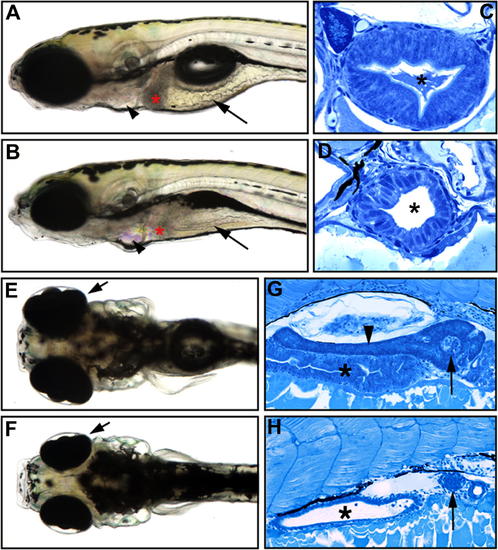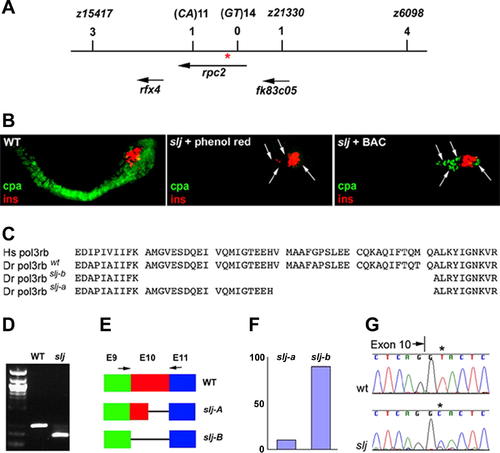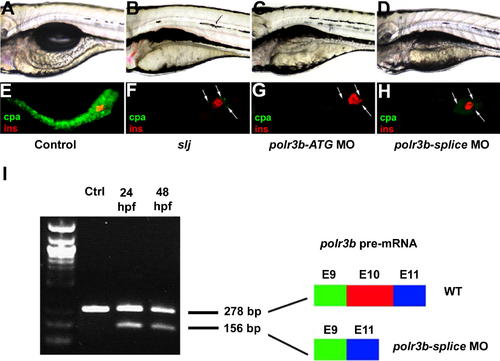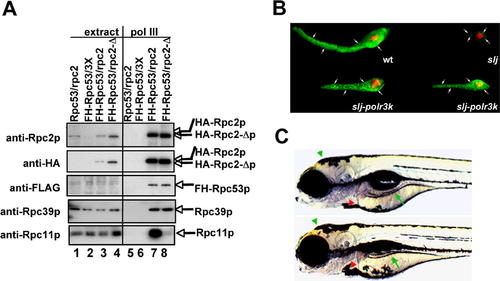- Title
-
Mutation of RNA Pol III subunit rpc2/polr3b Leads to Deficiency of Subunit Rpc11 and disrupts zebrafish digestive development
- Authors
- Yee, N.S., Gong, W., Huang, Y., Lorent, K., Dolan, A.C., Maraia, R.J., and Pack, M.
- Source
- Full text @ PLoS Biol.
|
The slj Mutation Disrupts Intestinal and Exocrine Pancreas Development (A–D) Lateral views of 5-dpf wild-type (A) and slj (B) larvae, with representative histological cross-sections (C and D). The slj intestine is small, thin walled, and lacks folds (arrows, [A and B]) compared with wild type, and the slj terminal branchial arches are reduced (arrowheads). The columnar morphology and apical microvilli of the slj epithelium are less developed than in wild-type larvae (C and D); an asterisk (*) indicates the intestinal lumen. (E and F) The size of the slj liver (indicated by red asterisk in [A] and [B]) and the retinae (arrows, [E and F], dorsal view) are also reduced. (G and H) Although exocrine tissue is well developed in wild-type embryos (arrowhead in [G]), it is markedly reduced or absent in slj embryos (H); asterisks indicate intestine. By contrast, the slj and wild-type pancreatic islets are of comparable size (arrows). PHENOTYPE:
|
|
The slj Locus Encodes Zebrafish polr3b, the Gene Encoding the Second Largest Subunit of RNA Pol III (A) Schematic of the region surrounding the slj locus. Genetic markers and the number of recombinants are listed above the names of the genes and expressed sequence tags (ESTs) that map to this region of zebrafish Chromosome 18. A zero recombinant marker (GT)14, is located within the polr3b coding region. Arrows denote orientation of gene transcription. Red asterisk (*) denotes location of slj mutation. (B) High-power, lateral views of the immunostained pancreas from a 5-dpf wild-type zebrafish larva (left panel), and two slj larvae microinjected with either phenol red vehicle (middle) or the BAC spanning the slj locus (right panel). All larvae were processed for insulin (ins, red) and carboxypeptidase A (cpa, green) immunohistochemistry. A normal pattern of immunoreactive insulin is present in all larvae. BAC injection restores cpa staining and therefore partially rescues the slj exocrine (carboxypeptidase A) defect. Arrows point to cpa-positive exocrine pancreas cells in the BAC-injected larva and note their absence in the slj larva. (C) Predicted amino acid sequence encoded by the human (Hs) and zebrafish (Dr) Polr3b cDNA surrounding the region deleted by the slj mutation. Two polr3b mRNA splice variants are generated by the slj mutation: the slj-b variant lacks all 41 amino acids encoded by exon 10 (aa239–279) of the polr3b gene, whereas the slj-a variant lacks 22 exon 10 amino acids (aa258–279). (D) PCR amplification of cDNA derived from pooled 5-dpf slj larvae and homozygous wild-type (WT) siblings using primers that span polr3b exon 10, as depicted in (E). Sequencing revealed that a 278-bp band is amplified from wild-type larvae, whereas a 155-bp band corresponding to deletion of exon 10 is amplified from slj larvae. (E and F) Schematic (E) depicting the wild-type and slj polr3b mRNAs exons 9–11 (E9, E10, and E11). Arrows refer to PCR primers used to quantify the relative proportion of the slj-A and slj-B transcripts (F) in the 5-dpf slj and wild-type larvae shown in (D). (G) Schematic depiction of the DNA sequences encoded by wild-type and slj polr3b alleles. The slj mutation encodes a thymine (T) to cytosine (C) transition in the intron 10 splice acceptor. PHENOTYPE:
|
|
Antisense Knockdown of Zebrafish polr3b Generates a slj Phenocopy (A–D) Lateral views of 5-dpf and wild-type zebrafish larvae injected with vehicle (control [A]) or Morpholinos targeting either the polr3b translation initiation codon (polr3b-ATG MO [C]) or the polr3b exon 10 splice donor (polr3b-splice MO [D]). The intestine in both Morpholino-injected larvae resembles the slj intestine (B). (E–H) Corresponding images of the immunostained pancreas from these larvae: note that there is minimal exocrine tissue in larvae injected with either polr3b Morpholino, as occurs in slj. cpa, carboxypeptidase A; ins, insulin. (I) Agarose gel electrophoresis showing RT-PCR products amplified from polr3b cDNA derived from wild-type (WT) embryos injected with the polr3b-splice Morpholino. In both 24-hpf and 48-hpf larvae injected at the one-cell stage, a 155-bp band corresponding to in-frame deletion of exon 10 is evident (confirmed by DNA sequencing), but not in control larvae. The 278-bp wild-type fragment is also evident in the Morpholino-injected larvae. PHENOTYPE:
|
|
polr3b Expression in Developing Zebrafish (A) Strong maternal polr3b expression is evident at 3 hpf. (B) Widespread polr3b expression is evident at 12 hpf. (C) At 24 hpf, polr3b expression is most pronounced in the nervous system. (D) At 48 hpf, liver and intestinal polr3b expression (white arrows) is evident. There is also diffuse expression in the nervous system at this stage. (E) A similar pattern of polr3b expression is evident at 72 hpf (intestine and liver—white and red arrows, respectively). Retinal and nervous expression is also apparent at this stages (black and green arrows, respectively). Nervous system expression was variable at this stage, whereas digestive organ and retinal expression was consistent. (F) Quantitative RT-PCR data showing the relative expression levels of polr3b during embryonic and larval development. Expression levels of polr3b are relative to hprt expression. |
|
Reduced Pol III Target Gene Expression in slj Larvae (A) Total tRNA levels are reduced relative to the amount of 5.8S rRNA (a gene transcribed by Pol I) in pooled 4-dpf and 5-dpf slj larvae compared with wild-type (WT) siblings, whereas levels of 5S rRNA, another Pol III target gene product, are normal. Identical RNA samples analyzed in (A and B). tRNA and 5S rRNA graphs represent an average of two measurements. Error bars indicate standard deviation. (B) Quantitative PCR data showing reduced levels of a tRNAleu gene in pooled 3-dpf and 5-dpf homozygous slj larvae compared with wild-type siblings relative to expression of hprt, a Pol II target gene. (C) Reduced levels of the Pol III target gene product 7SL RNA in pooled 4-dpf and 5-dpf slj larvae compared with wild-type siblings (as determined by quantitative real-time PCR). tRNAleu and 7SL expression are relative to the expression of the Pol II target gene hprt. (D) Northern analyses showing that the levels of mature tRNAleu and tRNAile transcripts are reduced 48% and 36% relative to U1 snRNA (a Pol II target gene) transcript levels in pooled 5-dpf slj larvae. This analysis also suggests a small reduction in slj 5S rRNA levels, although 5S rRNA levels relative to 5.8S RNA levels were normal when quantified by gel electrophoresis (Figure 5B). (E) Northern analyses showing reduced pre-tRNAile levels relative to U1 snRNA (unpublished data), in pooled 5-dpf slj versus sibling wild-type (WT) larvae. The pre-tRNAile transcript is the same size (89 bp) in slj and wild-type larvae. (M is a molecular weight marker.) (F) Quantitative real-time PCR data showing reduced pre-tRNAleu and pre-tRNAile expression relative to the Pol II target gene hprt in pooled 5-dpf slj versus pooled sibling wild-type larvae. |
|
The slj Mutation Targets Interaction of Pol III Subunits Rpc2/Polr3b and Rpc11/Polr3k in S. pombe and Zebrafish (A) Deletion of the region between aa267 and aa308 of S. pombe Rpc2 results in a deficiency of Rpc11p in the purified Pol III complex. Wild-type Pol III and mutant Pol III containing rpc2-Δ, in which the region between aa267 and aa308 of S. pombe Rpc2 was deleted, were purified from extracts prepared from FLAG-His6-Rpc53p strains expressing Rpc2p (“FH-Rpc53/rpc2”), Rpc2-Δp (“FH-Rpc53/rpc2-Δ”), or empty vector (“FH-Rpc53/3X”) as described in Materials and Methods. Mock purification was also performed with control extracts prepared from a wild-type untagged strain (“Rpc53/rpc2”). The input extracts (lanes 1–4) and the purified Pol III (lanes 5–8) were fractionated by 4%–20% sodium dodecyl sulfate (SDS)-polyacrylamide gel electrophoresis and analyzed by immunoblotting using antisera indicated on the left; the detected proteins are indicated on the right. The amounts of input loaded relative to that used for purification are 0.4% lane 1; 0.13% lane 2; 0.1% lane 3, and 0.1% lane 4. A total of 5% of the purified material was loaded in lanes 5–8. (B) Lateral view of the pancreas from a 5-dpf wild-type (wt) larva, a 5-dpf slj larva (slj), and two 5-dpf slj larvae that were microinjected with a hsp70/polr3k expression construct (slj-polr3k), following heat shock (as described in Materials and Methods), and carboxypeptidase A (green) and insulin (red) immunohistochemistry. Expression of the polr3k cDNA from the hsp70 heat shock promoter induces partial rescue of the slj exocrine pancreas phenotype. (C) Lateral views of a 5-dpf control wild-type (wt) and polr3k Morpholino-injected larvae (polr3k-MO). The polr3k knockdown produces a phenotype that is similar to that caused by the slj mutation (Figure 1B). The intestine (green arrow), cranial morphology (green arrowhead), and terminal branchial arches (red arrowhead) are reduced with polr3k knockdown. PHENOTYPE:
|






